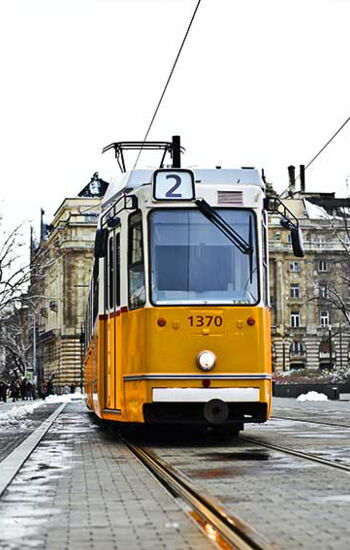Track insulation I Structure-borne
noise is unhealthy
Reduction of structure-borne noise
In addition to the acoustically audible airborne noise, trams also generate structure-borne noise. This low-frequency structure-borne noise is transmitted through the superstructure and substructure, tunnels, bridges, the surrounding ground as well as building walls into the respective rooms of a house. Ceilings and walls are thus made to vibrate by the passing trains and radiate airborne noise. The structure-borne noise transmitted into buildings by the trams and the resulting secondary noise usually covers a frequency range between about 16 Hz and 160 Hz, in exceptional cases up to about 350 Hz. Clanging tableware in the cupboard and cracks in the walls of the house are possible results of underperforming insultation.
Quality of life despite strong urbanisation
The reduction of structure-borne noise is therefore one of the most important tasks of a continuous track system! Especially in densely populated residential areas, a permanent reduction of shocks and vibrations is essential. This not only serves to protect sensitive systems and equipment, such as those found in hospitals, but also to protect buildings and their occupants. For this purpose, we offer effective solutions for vibration reduction and support future construction projects as specialists in this field.
With urbanisation, cities are growing and with them rail-bound traffic is moving ever closer to the built-up area.
"Vibrations can have a significant impact on the environment and severely affect the quality of life."
To prevent negative effects and still enable the expansion of cities and their infrastructure, we offer a simple and very efficient solution with our products. By combining different components, SEALABLE is able to design the right system for your rail deflection requirements and the resulting insulation. It is perfectly suited for any type of rail profile, as well as switches and crossings. The individual components can be adapted according to your requirements regarding rail deflection.
With just a few accessories, we guarantee you a cost-saving, perfect installation and successful protection against shocks and vibrations in the immediate surrounding area.
Matthias Klug, Managing Director
Rail deflection and insertion loss
In addition to the properties of the elastomers used, rail deflection is the decisive factor for insertion loss. The amount of rail deflection in turn depends on the stiffness (static and dynamic) of the elastic materials used.
With the higher rail deflection, the weight of the rail vehicle is distributed over a longer bending line and consequently the load is shifted to more support points, i.e. the load-distributing effect of the rail is more strongly activated. This measure in turn achieves a reduction of the introduced structure-borne noise into the surrounding structure. The rail deflection can be calculated with the characteristic values of the axle load, the axle distances and the superstructure.
The results of our products prove that the prescribed maximum rail deflection is complied with by the transport companies.
7 GOOD REASONS FOR OUR ELASTIC RAIL ENCAPSULATION
- Reduction of structure-borne noise
- Protecting surrounding buildings from shocks and vibrations
- Improving the quality of life in densely populated areas
- Extends the prescribed maximum rail deflection by an elastic component
- Individually adjustable rail deflection and resulting insulation
- Sustainable and long-lasting rail encapsulation

